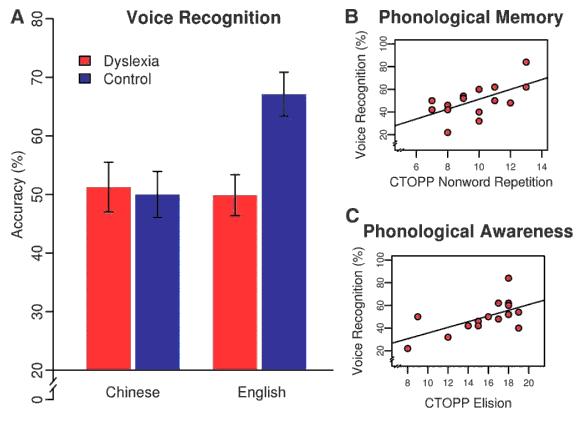这篇文章为什么能发表在Science上?
(2011-11-03 21:15:00)
http://ilabs.washington.edu/sites/default/files/Science-2011-Perrachione-595.pdf
今年7月29日Science上刊登了一篇题为《Human Voice Recognition Depends on Language Ability》的文章,作者是美国MIT的三位研究者。文章的篇幅只有一页,字数不足700个英语单词,只有一个行为实验,既没有采用先进的实验设备,也没有使用复杂的统计方法,结果也只是一张图表。在昨天的《星期三》讨论会上,课题组的一位研究生向大家介绍了这篇文章,引起了大家很大的兴趣和热烈的讨论。就是这样一篇文章,为什么能发表在“顶尖级”的刊物Science上呢?
我个人认为,可能有几个原因,提出来供大家思考:
1,提出了一个好的科学问题。这篇文章采用了成人阅读困难者和正常阅读者(控制组)为被试,比较了他们在识别熟悉的母语(英语)和不熟悉的语言(汉语)嗓音上的差异。结果发现,两组被试在母语的嗓音识别上有明显差异,而在第二语言的嗓音识别上没有差异。如果文章的作者仅仅关注阅读困难者存在什么认知缺陷,而且用结果来说明“语音表征缺陷”是阅读困难者最重要的认知缺陷,那么这个结果只是支持了目前国际学术界关于阅读困难的一种理论,成果的原始创新性就会大打折扣。作者们没有从阅读困难的角度提出问题,而是提出了一个新的假设,即不同语言能力对人类的嗓音识别的影响。文章把两组被试的差异看成是语言能力的差异,即语音表征上的差异。对于熟悉的语言(母语),语音表征的影响大,因而两组被试在识别母语嗓音时有差异;而对不熟悉的语言,这种差异可能就消失了。结果很好的支持了上述假设。语音识别问题是一个非常前沿的科学问题,而语言能力与语音识别的关系,很少有人进行过探讨,这是这篇文章的一大靓点。爱因斯坦说得好:提出一个问题往往比解决一个问题更重要,因为解决问题也许仅是一个数学上和技术上的技能而已。而提出新问题,新的可能性,从新的角度去看旧问题,却需要有创造性的想象力,而且标志着科学的真正的进步。我没有问过作者本人,也许他们在开始研究这个问题时,也是从阅读困难的角度提出问题,以后才想到这个更好的问题。人往往不是先知先觉者,而是后知后觉者,只有在反复、不断深入的思考中,才能发现和找到更好的问题。因此,我在《星期三》会议上多次说过,要把“提出问题”贯穿在研究的始终,要用问题来引导研究,从提出问题,到实验设计,到数据处理,到文章写作,使之不断向纵深发展。
2,有一个高起点的开头。文章开头难,这是大家都熟知的一个事实。这篇文章没有从“阅读困难“这个大家已经熟悉的问题开始,而是从动物(包括人类)的嗓音识别开始,这是近年来研究“语言与脑的进化”关系中一个很吸引人的问题。记得力海曾经在介绍他的写作经验时说过,好文章在开始时一定要引用“高端刊物的文献”,要关注最前沿的有重大意义的理论问题,使自己立足于高起点,高水平。我想这是很有道理的。文章的起点站得不高,提出的问题不是学术界普遍关心的重要问题,也就很难有希望发表在高端的国际刊物上。
3,选在了一个有特色的实验任务。在以往关于阅读障碍的研究中,研究者通常都采用词汇水平的语音或语义判断任务,如押韵判断任务、词汇判断任务、语义范畴判断任务等。本文作者别出心裁,采用了嗓音匹配任务,即要求被试判断所听到的句子是5位说话者中的哪位说的,这也是作者另避蹊径的地方。实验任务或实验范式的创新,需要研究者创造性的思考,一种新的范式常常会为研究开辟一个新的天地,揭示出许多未知的现象和规律。
当然,发表一篇好文章,还需要许多其他的条件,如研究者在某个领域的研究积累和声望,写作经验和能力等等。本文的通信作者在这个领域很有影响,已经在Science上发表过文章,这些就不必分析了。
=================
Human Voice Recognition Depends on Language Ability
Tyler K. Perrachione, 1 * Stephanie N. Del Tufo, 1 John D. E. Gabrieli 1,2 *
The ability to recognize individual conspecifics from their communicative vocalizations is an adaptive trait evinced widely among social and territorial animals, including humans. Studies of human voice recognition compare this ability to nonverbal processes, such as human perception of faces or nonhuman animals’ perception of vocalizations (1). However, the human voice is also the principal medium for the human capacity of language, as conveyed through speech. Human listeners are more accurate at identifying voices when they can understand the language being spoken (2), an advantage thought to depend on listeners’ knowledge of phonology— the rules governing sound structure in their language. Leading theories of dyslexia propose that impoverished phonological processing often underlies impaired reading ability in this disorder (3, 4). We therefore hypothesized that, if voice recognition by human listeners relies on linguistic (phonological) representations, listeners with dyslexia would be impaired compared with control participants when identifying voices speaking their native language (because of impaired phonological processing) but unimpaired in voice recognition for an unfamiliar, foreign language (where both individuals with and without dyslexia lack relevant language-specific phonological representations).
We assessed participants with and without dyslexia for their ability to learn to recognize voices speaking either the listener’s native language (English) or an unfamiliar, foreign language (Mandarin Chinese). In each language, participants learned to associate five talkers’ voices with unique cartoon avatars and were subsequently tested on their ability to correctly identify those voices. The participants’ task was to indicate who of the five talkers spoke in each trial [fivealternative forced choice; chance = 20% accuracy (5)]. Despite using the same vocabulary, all speakers of a language differ in their pronunciations of words (6), and listeners can use their phonological abilities to perceive these differences as part of a speaker’s vocal identity. A repeated-measures analysis of variance revealed that, compared with controls, dyslexic participants were significantly impaired at recognizing the voices speaking English but unimpaired for those speaking Chinese (group × condition interaction, P < 0.0006) (Fig. 1).
English-speaking listeners with normal reading ability were significantly more accurate identifying voices speaking English than Chinese ( paired t test, P < 0.0005), performing on average 42% better in their native language (7). Englishspeaking listeners with dyslexia were no better able to identify English-speaking voices than Chinese-speaking ones (paired t test, P = 0.65), with an average performance gain of only 2% in their native language. Correspondingly, dyslexic listeners were significantly impaired compared with controls in their ability to recognize Englishspeaking voices (independent-sample t test, P < 0.0021). Dyslexic listeners were as accurate as controls when identifying the Chinese-speaking voices (independent-sample t test, P = 0.83), demonstrating that their voice-recognition deficit was not due to generalized auditory or memory impairments. Moreover, for the dyslexic participants, greater impairments on clinical assessments of phonological processing were correlated with worse accuracy for identifying Englishspeaking voices (both Pearson’s r > 0.6, P < 0.015). Although the diagnostic criterion for dyslexia is impairment in developing typical reading abilities, these data show that reading difficulties are accompanied by impaired voice recognition. This inability to learn speaker-specific representations of phonetic consistency may reflect a weakness in language learning that contributes to impoverished long-term phonological representations in dyslexia.
For humans, the ability to recognize one another by voice relies on the ability to compute the differences between the incidental phonetics of a specific vocalization and the abstract phonological representations of the words that vocalization contains. When the abstract linguistic representations of words are unavailable (because the stimulus is unfamiliar, as in foreign-language speech) or impoverished (because native-language phonological representations are compromised, as in dyslexia), the human capacity for voice recognition is significantly impaired. This reliance on our faculty for language distinguishes human voice recognition from the recognition of conspecific vocalizations by other nonhuman animals.
References and Notes
1. P. Belin, S. Fecteau, C. Bédard, Trends Cogn. Sci. 8, 129 (2004).
2. T. K. Perrachione, P. C. M. Wong, Neuropsychologia 45, 1899 (2007).
3. L. Bradley, P. E. Bryant, Nature 301, 419 (1983).
4. J. D. E. Gabrieli, Science 325, 280 (2009).
5. Materials and methods are available as supporting material on Science Online.
6. J. Hillenbrand, L. A. Getty, M. J. Clark, K. Wheeler, J. Acoust. Soc. Am. 97, 3099 (1995).
7. Native Chinese-speaking controls exhibit the opposite pattern, recognizing Chinese-speaking voices more accurately than English-speaking ones (2), revealing the critical factor to be listeners’ language familiarity, not properties inherent to the voice stimuli or languages themselves.
Acknowledgments: We thank J. A. Christodoulou, E. S. Norton, B. Levy, C. Cardenas-Iniguez, J. Lymberis, P. Saxler, P. C. M. Wong, C. I. Moore, and S. Shattuck-Hufnagel. This work was supported by the Ellison Medical Foundation and NIH grant UL1RR025758. T.K.P. is supported by an NSF Graduate Research Fellowship.
Supporting Online Material
www.sciencemag.org/cgi/content/full/333/6042/595/DC1 Materials and Methods Fig. S1
Table S1
References (8–16)
21 April 2011; accepted 16 June 2011
10.1126/science.1207327
1 Department of Brain and Cognitive Sciences, Massachusetts Institute of Technology (MIT), Cambridge, MA 02139, USA. 2 McGovern Institute for Brain Research and HarvardMIT Division of Health Sciences and Technology, Cambridge, MA 02139, USA. *To whom correspondence should be addressed. E-mail: tkp@mit.edu (T.K.P.); gabrieli@mit.edu (J.D.E.G.)
Fig. 1. (A) Mean voice-recognition performance of dyslexic and control listeners (error bars indicate SEM). All individuals scored above chance (20%), shown as baseline. (B and C) Relationships between clinical measures of language (phonological) ability in dyslexia and voice-recognition ability. CTOPP, Comprehensive Test of Phonological Processing
www.psychspace.com心理学空间网

